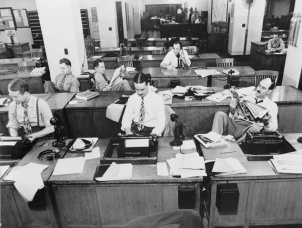There is no doubt that public relations professionals have an important relationship with journalists. But, have you ever considered what your PR agency, firm or in-house department can learn from the running of a news room?
A few of our staff at Pesel & Carr had the opportunity to tour The Age Media House last week with Colin McKinnon, a veteran journalist who is now in charge of training and development for Fairfax editorial staff.
Here are some key principles and advice we took that you can incorporate in your own PR world.
1. Don’t just know your audience; know what they do
In a news room, reader behaviour dictates news distribution; it is not the other way around. Articles are posted at specific times and on specific platforms when the audience is most likely to read them.
Website analytics show what people are reading and how long they are reading for. News rooms track these trends very closely to find out what to post more of and what needs to be promoted – and you should too.
People are most active on mobile devices on their way to and from work and in the evening as they are watching television, while websites are visited more often during the work lunchbreak. Not only should you know these activities, but you should be using them to your advantage.
There is no point in posting quality content online if there is no one on the other side of the screen reading what you have to say.
2. Smarter employment is vital
Young employees are extremely valuable in our industry as they live the social media trends that organisations attempt to capitalise on. Younger journalists teach experienced ones new tricks with digital technologies, while experienced journalists pass on their wisdom of traditional journalism values such as cross-checking sources, accuracy and quality writing.
People who have skills in more than one discipline are also vital in any communications workplace that relies on utilising different channels and mediums to deliver content. News rooms are relying on multi-skilled workers more and more due to their decreasing sizes.
3. Research, then research again
The old-school emphasis of research still applies in the digitally-driven newsroom of today. Five librarians work at The Age Media House and they even have an excessive collection of actual books and documents.
Good research skills not only include knowing where to look and what to look for, but also cross-checking your facts and sources. This is crucial for delivering effective pitches and upholding a credible image.
4. You can be successful in the internet era
Your organisation can still be successful even if it is not inherently digitally-inclined. All it takes is a little creativity and a willingness to change.
In order to be efficient on the digital landscape, content sharing across platforms in a news room is more frequent than ever before. Less freelance contribution to newspapers helps to save in-house jobs and the use of laptops instead of desktop computers allows for optimal use of office space.
The Age runs alternate companies such as RSVP and CarSales and charges for online subscriptions and digital ad space, so do not be afraid to also think outside the box and try something new.
It is also helpful to think about the way journalists and sub-editors change the headlines of their stories from print to online. When you are writing something for print, a catchy or humorous headline works perfectly to capture attention and create intrigue. However, when creating an online piece, headlines need to be concise and include key words for SEO and to interest the multi-tasking mobile user.
Just like a news room, PR workplaces can survive and flourish in today’s media environment when they embrace the changes and take advantage of the new opportunities presented.


